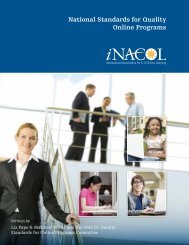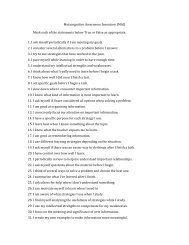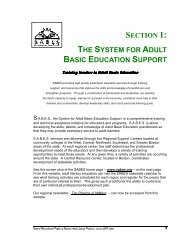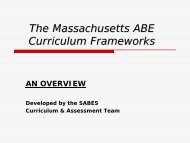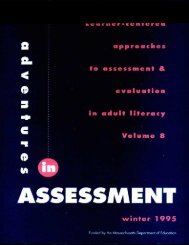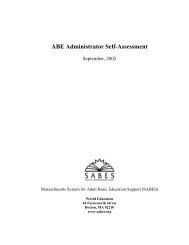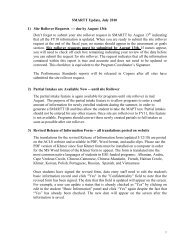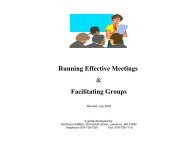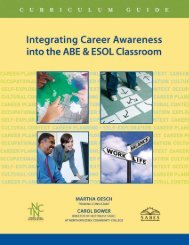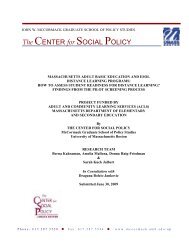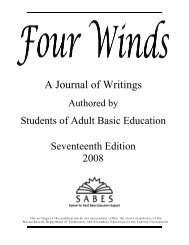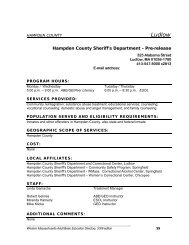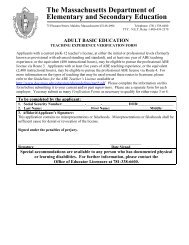PAWG I Final Report - SABES
PAWG I Final Report - SABES
PAWG I Final Report - SABES
You also want an ePaper? Increase the reach of your titles
YUMPU automatically turns print PDFs into web optimized ePapers that Google loves.
The Massachusetts Adult Basic Education<br />
Performance Accountability Working Group<br />
P A W G<br />
FINAL REPORT<br />
30 September 2002
The Massachusetts ABE<br />
Performance Accountability Working Group<br />
<strong>Final</strong> <strong>Report</strong><br />
This report is organized as follows:<br />
1. Overview: Background, <strong>PAWG</strong> Statement of Purpose and Questions (pages 2-3)<br />
2. Purposes for the ABE Performance Accountability System: laws and requirements according to<br />
WIA and the state, how well we are serving our students, and implementing continuous improvement<br />
(pages 4-5)<br />
3. Student Primary Assessment: short- and long-term recommendations for testing and accompanying<br />
challenges (pages 5-10)<br />
4. Student Goals and Countable Outcomes: both a chart and a narrative description are provided as well<br />
as a list of accompanying challenges (pages 10-12)<br />
5. A Cohesive System and Unfinished Business: a description of how the system fits together and a<br />
presentation of issues we must resolve in its implementation, what remains, and the plans for a “<strong>PAWG</strong><br />
II” in January 2003 (pages 12-14)<br />
For more information on the topics within this document, please refer to the <strong>PAWG</strong> Notes posted at the<br />
<strong>SABES</strong> web site at http://www.sabes.org, or to the Assessment Policy Manual available on line from the<br />
Massachusetts Department of Education Adult and Community Learning Services at<br />
http://www.doe.mass.edu/acls/news.htm.<br />
Members of the <strong>PAWG</strong> would like to thank Marie Cora, Dineen Casilli, Robert Foreman, Jane<br />
Schwerdtfeger and others who drafted and edited this report.<br />
1. OVERVIEW<br />
This summary report is intended for ABE practitioners and other stakeholders and interested parties in<br />
Massachusetts. It briefly outlines the work of the Performance Accountability Working Group (<strong>PAWG</strong>)<br />
over the past one-and-a-half years, focusing on how we arrived at and grappled with various ABE<br />
performance accountability issues, and they were resolved. It is intended to give the field a sense of how<br />
we dealt with the enormity of developing a statewide system of accountability. Of special concern to the<br />
<strong>PAWG</strong> was how to balance the demands of an accountability system that honors the “breadth” of our work<br />
(the diverse, rich and complex purposes that motivate our students to enroll) with the goal of keeping these<br />
demands as manageable for programs and staff as possible. To this end, the <strong>PAWG</strong> consistently found<br />
itself making compromises as it determined what elements to include in the performance accountability<br />
system.<br />
The <strong>PAWG</strong>’s recommendations cover two main components of the ABE performance accountability<br />
system we envision: Student (“Primary”) Assessment, and Student Goals achieved or Countable Outcomes.<br />
It is important to keep in mind that the <strong>PAWG</strong>’s work provides a starting point. We did not develop the<br />
whole system; we began to develop components of that system. We did not develop new assessments; we<br />
explored and selected from a variety of available assessments and recommended assessments that need to<br />
be developed consistent with the Massachusetts ABE Curriculum Frameworks. We did not finish our<br />
business; we set in motion a work-in-progress to fully develop an accountability system within our state.<br />
We regard the next few years as an interim period that ensures we are in compliance with federal<br />
requirements while we continue to work steadily at building an effective ABE system of services in<br />
Massachusetts that reflects our values and the dreams and aspirations of our students.<br />
Performance Accountability Working Group / <strong>Final</strong> <strong>Report</strong> / September 2002 / page 2
Background<br />
In February 2001, the Performance Accountability Working Group (<strong>PAWG</strong>) was convened by the<br />
Massachusetts Department of Education (DOE/ACLS). The immediate catalysts for its creation were<br />
performance accountability requirements already stipulated by the federal Workforce Investment Act<br />
(WIA) as well as related requirements that were beginning to emerge at the State level. The purpose of the<br />
<strong>PAWG</strong> was to make recommendations for meeting these federal and state requirements for performance<br />
accountability by July 1, 2002 with a system that was genuinely responsive to:<br />
• our diverse student population,<br />
• the multiplicity of reasons for their enrollment, and<br />
• the continuous improvement of our programs and the services we provide.<br />
The <strong>PAWG</strong> researched how other states have chosen to meet the WIA requirements with the result that<br />
Massachusetts compiled a comprehensive report of ABE performance accountability implementation in all<br />
50 states 1 . We found that most other states have adopted standardized tests such as the TABE, the BEST,<br />
or CASAS, and that some are attempting to develop and implement a more inclusive approach to learner<br />
assessment: one that reflects more than the results of a paper and pencil test. Examples of these efforts<br />
include states such as Ohio that are in the process of standardizing a portfolio approach to assessment, or<br />
states that are adopting Equipped for the Future (EFF) to measure “educational gain,” such as Maine. Most<br />
states are using a statewide database built from the individual student level up, however, few honored goals<br />
that students might have for participating in the program (<strong>PAWG</strong> refers to these as “countable outcomes”)<br />
other than those stipulated by WIA. Massachusetts delayed making choices about assessments and<br />
countable outcomes until it analyzed the existing and emerging systems used by the other states.<br />
Our research confirmed that Massachusetts had an important head start in defining the “universe of<br />
content” to be assessed. For more than five years, practitioners around the state have contributed to the<br />
development of the Massachusetts ABE Curriculum Frameworks and to the development of assessment and<br />
evaluation procedures that align with the Frameworks. These and other "home grown" or programdeveloped<br />
assessment materials, as well as commercially available tests selected by programs, have formed<br />
the basis for our accountability system in the past. This work by practitioners has been central to our<br />
system development. In addition, it has informed the work of the <strong>PAWG</strong>. The Curriculum Frameworks<br />
form a centerpiece of our system, and it is our intention to develop and adopt assessment tools fully aligned<br />
with the Frameworks. In many instances, this turns out to be a long-term goal. For the next few years, we<br />
must necessarily adopt assessments that fall short of this goal in order to be in compliance with state and<br />
federal requirements. These short-term recommendations are outlined in Section 3 of this document.<br />
The <strong>PAWG</strong> employed several different processes and frameworks to help guide the work. These included<br />
small group structures to conduct research in different areas and a series of questions that helped provide a<br />
syllabus of sorts for us to follow. Following is the <strong>PAWG</strong> Statement of Purpose and guiding questions. A<br />
listing of <strong>PAWG</strong> members and small group make-up are found in Appendixes A & B.<br />
1 Available on the ACLS web site at http://www.doe.mass.edu/acls/news.htm.<br />
Performance Accountability Working Group / <strong>Final</strong> <strong>Report</strong> / September 2002 / page 3
<strong>PAWG</strong> Statement of Purpose<br />
The Performance Accountability Working Group (<strong>PAWG</strong>) is a group of<br />
practitioners and Department of Education staff who are working together to<br />
develop a performance accountability system for adult basic education<br />
programs.<br />
To this end, the <strong>PAWG</strong> must attempt to answer and define the following questions:<br />
1. What is the scope/breadth of what we mean by “ABE Performance Accountability?”<br />
2. To whom and for what should the Massachusetts ABE service delivery system be held accountable?<br />
3. What measures can and should be used to document performance in ABE?<br />
4. What constitutes valid and reliable measures of student and program performance?<br />
5. What level of proficiency must students attain in order to receive a “terminal degree” (i.e.: GED,<br />
AD/ED) within the ABE service delivery system?<br />
6. What other benchmarks and associated levels of proficiency would be appropriate and useful for our<br />
students to attain?<br />
7. To what extent are funded ABE programs responsible for student performance, including the attainment<br />
of performance benchmarks?<br />
8. What levels of program performance are expected?<br />
9. What support do programs need and deserve from the state, from <strong>SABES</strong>, and from each other in order<br />
to meet performance expectations?<br />
10. What are the consequences of strong, average, and/or weak performance over time?<br />
2. PURPOSES FOR THE ABE PERFORMANCE ACCOUNTABILITY SYSTEM<br />
In recent years, several policy initiatives at both state and federal levels have shifted the focus of adult basic<br />
education programs from simply providing services to demonstrating the impact of the services provided<br />
and developing specific results. At the federal level, the 1998 Workforce Investment Act (WIA) called for<br />
the establishment of a comprehensive performance accountability system in each state to assess the<br />
effectiveness of federally funded ABE programs in delivering adult education and literacy services. States<br />
receiving federal ABE funding are required to express core indicators of performance in an objective,<br />
quantifiable and measurable form, and they must be able to show progress toward continually improving in<br />
performance. At the state level, the MADOE must be able to document program performance to the<br />
administration and to legislators in order to keep funds flowing to programs for services. The performance<br />
accountability system being developed in this state must not only allow the Department to make informed<br />
funding decisions and defend its requests for funding with reliable and valid data, it must ensure that the<br />
ABE related goals and aspirations of students remain at the heart of this work.<br />
Performance Accountability Working Group / <strong>Final</strong> <strong>Report</strong> / September 2002 / page 4
As indicated above, the purposes of the performance accountability system can be broken into two<br />
principal areas: to assess performance and to inform stakeholders. In the ABE field, we assess performance<br />
at a variety of levels and we inform a broad array of audiences. At the classroom level we assess student<br />
performance in order to guide curriculum development and instruction and to inform students and teachers<br />
of educational gains. Programs are accountable to students for providing meaningful instruction that<br />
enables students to meet their goals. At the same time, programs are accountable to funders for putting<br />
available resources to the best possible use in serving the maximum number of students in the most<br />
effective way. This requires programs to gather objective, quantifiable, and reliable data to report to the<br />
Department of Education. The Department, in turn, is accountable to the governor, the legislature, the U.S.<br />
Department of Education, Congress, and to the taxpayers for providing oversight to funded programs.<br />
MADOE must ensure that the outcomes of the ABE system in Massachusetts efficiently and effectively<br />
meet the needs of residents and other stakeholders (e.g., businesses, higher education, etc.) in the<br />
Commonwealth.<br />
3. STUDENT PRIMARY ASSESSMENT<br />
An important portion of the <strong>PAWG</strong>’s role was to develop recommendations for the Department on what<br />
aspects of student performance to assess and how to best assess them. The National <strong>Report</strong>ing System<br />
(NRS), which was developed in response to the requirements of WIA, identified core indicators of<br />
performance for ABE programs. These include educational gains in English literacy and numeracy skills<br />
and follow-up measures including entering employment, retaining employment, receipt of a secondary<br />
school diploma or GED, and placement in post-secondary education or training. There are also secondary<br />
outcomes and measures that represent broader goals that students might strive for through their ABE<br />
enrollment. (See Guidelines for the National <strong>Report</strong>ing System available on line at<br />
(http://www.air.org/publications/publications-set.htm.)<br />
The core measures of educational gains and follow-up measures described in WIA are those most important<br />
for federal reporting at the program level and, as such, were the source of a great deal of discussion and<br />
research activities among <strong>PAWG</strong> members.<br />
A major concern for reporting in any system – be it for SMARTT, NRS, or in preparing a household budget<br />
– is that the data be valid, reliable and comparable. Otherwise, no significant conclusions can be reached or<br />
comparisons made with regard to the data collected; progress and accomplishments cannot be evaluated<br />
with confidence. For the data to be valid, they must accurately reflect the expected outcomes of the task.<br />
In education, the task is that students acquire a “universe” of knowledge, skills and abilities. This universe<br />
is generally articulated in the curriculum and/or a curriculum framework. Assessment items/tasks must be<br />
aligned with the learning standards of the Curriculum/Curriculum Framework in order to provide valid<br />
information about student acquisition of the knowledge, skills and abilities in question. Pre/post<br />
assessments aligned with the standards are needed to measure student learning gains. To be reliable, the<br />
data must be consistent when collected from similar sources using similar methods. What this means for<br />
ABE programs across the Commonwealth is that they must use a standardized process for assessing student<br />
performance and for reporting the results. There must be a pretest to determine where the student is at the<br />
beginning of instruction and a post-test to indicate any educational gains.<br />
One of the primary tasks of the <strong>PAWG</strong> was to determine what would be tested using the primary<br />
assessments, what instruments would be used, and how the results would be reported. Three of the<br />
Working Groups within the <strong>PAWG</strong> (see Appendix B) were assigned the work of researching available tests<br />
Performance Accountability Working Group / <strong>Final</strong> <strong>Report</strong> / September 2002 / page 5
used both within Massachusetts and nation-wide, and making recommendations to the full committee based<br />
upon this research. The following process was used to develop the groups’ recommendations 2 :<br />
• The first step was to review the standards in the three basic skills frameworks: ABE Mathematics, ABE<br />
English Language Arts (ELA), and English for Speakers of Other Languages (ESOL) to determine<br />
which standards should be assessed on a statewide basis and which would best be assessed locally.<br />
Additionally, we determined if the standard was written in a form that could be reliably and consistently<br />
measured and made modifications where indicated.<br />
• The next step was to compare available assessment instruments to the Massachusetts ABE Frameworks<br />
to see how completely they addressed the standards in the frameworks. Included in this research were<br />
the major tests used nationally by USDOE- funded programs as identified through a national survey<br />
conducted by MADOE 3 . The group also reviewed the “homemade” tests submitted by Massachusetts<br />
ABE programs in response to the Department’s assessment crosswalk request.<br />
• While the comparisons of the tests and Frameworks were being conducted, another review of the<br />
technical data and field trial results of the commercially produced instruments (TABE and BEST) was<br />
conducted by DOE staff to determine the level of validity, reliability, and comparability achieved<br />
through their test development processes.<br />
• When the research was complete, each working group reported back to the group as a whole with both<br />
written reports and oral presentations. The <strong>PAWG</strong> then discussed and debated the results as a group<br />
and voted on recommendations for how the Department of Education should proceed – both on a shortterm<br />
and long-term basis.<br />
Recommendations for Assessing Learning Gains<br />
A. SHORT TERM (three to five years) Assessment Recommendations for ABE Reading, Writing, and<br />
Mathematics:<br />
The <strong>PAWG</strong> researched and correlated the major tests used nationally (TABE, AMES, ABLE and CASAS)<br />
to the Curriculum Frameworks standards to see how well each assessment/test covered the standards<br />
included in the Frameworks. The commercially available assessment that came closest to alignment with<br />
the ELA and Math Curriculum Framework standards was the TABE. (The AMES test also was close to the<br />
TABE in its coverage of the learning standards, but there is some uncertainty right now in the publication<br />
of the AMES.)<br />
Unfortunately, “closest” still only represents a 56% correlation of the TABE’s test items with learning<br />
standards in the math framework and even less for alignment with the English Language Arts standards.<br />
Further, there are almost no items at the beginning literacy levels (GLE 0 to 1.9) that align with the learning<br />
standards in either framework. <strong>Final</strong>ly, the TABE is also limited in the degree to which it meets the<br />
<strong>PAWG</strong>’s third overriding goal as stated earlier - assessments must provide useful information to teachers<br />
and students. These are three of the reasons why the TABE is not recommended as a long-term solution for<br />
assessing ABE Reading, Writing and Math.<br />
2 Note: To see how the <strong>PAWG</strong>’s recommendations translated into assessment policy for the Department of Education you can<br />
download the Assessment Policies and Procedures Manual from the ACLS web site at http://www.doe.mass.edu/acls/news.htm.<br />
3 http://www.doe.mass.edu/acls/news.htm. 10-02-01<br />
Performance Accountability Working Group / <strong>Final</strong> <strong>Report</strong> / September 2002 / page 6
Therefore, for the next three to five years only, the TABE, Forms 7 and 8 have been recommended as the<br />
primary assessment for ABE reading, writing and math. It is not recommended, however, as the primary<br />
assessment for the beginning levels of literacy (GLE 0 – 1.9). Programs should use their previously<br />
approved crosswalk assessment tool for students identified as functioning at this level. (NOTE: If the<br />
program’s beginning approved literacy assessment tool was the TABE, please contact your <strong>SABES</strong><br />
Curriculum and Assessment Coordinator for guidance in selecting a replacement.)<br />
B. SHORT-TERM Assessment Recommendations for ESOL Assessments:<br />
Two assessments that align quite well with the adult ESOL framework learning standards are two<br />
performance-based assessments: the BEST (Basic English Skills Test) for speaking and listening, and the<br />
REEP (developed by the Arlington Education and Employment Program, part of the Arlington, Virginia<br />
Public Schools) for writing. The <strong>PAWG</strong> was unable to recommend an assessment for ESOL reading.<br />
The <strong>PAWG</strong>’s research showed that the BEST test’s ability to capture educational gain begins to “plateau,”<br />
(i.e., not test higher level skills) at SPL 5. We are also aware that administering this performance<br />
assessment one-on-one will be time consuming to administer – one of the “tradeoffs” the <strong>PAWG</strong> struggled<br />
with as it considered the strong validity of performance assessments but also the heavy demands they place<br />
on program and instructional resources.<br />
Our research also showed that the REEP currently has only one prompt for placement and two prompts to<br />
assess educational gain that have been satisfactorily standardized. [NOTE: The Department of Education<br />
is entering into a partnership with the Arlington, VA program to develop and standardize additional<br />
prompts for the REEP writing assessment. We hope to have additional prompts available for FY 2004, and<br />
to potentially have at least one new prompt for the end of FY 2003.]<br />
For the longer term, the <strong>PAWG</strong> recommends we evaluate the forthcoming BEST PLUS test, which is<br />
expected to be released in January 2003, as well as local assessments for their potential to be standardized<br />
for use at the state level. Members of the <strong>PAWG</strong> have asked the Department to analyze the BEST PLUS<br />
and the REEP to determine whether they can serve as our long-term solution for ESOL assessments (refer<br />
to following section). In addition, we strongly encourage programs to use other assessments, particularly<br />
performance-based assessments, for reading. Since new assessments require extensive standardization, it<br />
will take time before we can develop and use any new Massachusetts-specific assessments statewide to<br />
obtain reliable measures of educational gain.<br />
C. GAPS in the short term assessment protocols<br />
There were some areas of student assessment for which the <strong>PAWG</strong> was not able to find valid, reliable and<br />
comparable assessments even for the short term – several of these were apparent during the <strong>PAWG</strong>’s<br />
deliberations and other issues emerged as programs considered the new assessment policies. For the<br />
purpose of providing a more complete review, all the issues we are aware of at the time this report is<br />
published are covered in the following list. It is also noted when a conclusion is authored by the<br />
Department rather than the <strong>PAWG</strong>. Pending issues are as follows:<br />
(1) For ABE students at the GLE level 0 – 1.9, programs will continue to use the same instrument they<br />
used last year (consistent with their approved “crosswalk”) while the Department of Education<br />
determines valid and reliable assessments for this group of students (with the exception of TABE 5-6).<br />
Performance Accountability Working Group / <strong>Final</strong> <strong>Report</strong> / September 2002 / page 7
(2) For ESOL Students who are at (or may enter) SPL 6 during the program year:<br />
Programs should administer the REEP writing assessment to these students regardless of whether<br />
“writing” is related to their goal(s) for enrolling in the program. This is essential because the original<br />
BEST appears to plateau at SPL 5 and is unable to provide reliable measures of educational gain<br />
beyond this level.<br />
(3) For ESOL Students who select reading as their primary assessment goal:<br />
The <strong>PAWG</strong> was unable to recommend a reading assessment that was valid and reliable. A new <strong>PAWG</strong><br />
Working Group will be convened in January 2003 to research and make recommendations on a reading<br />
assessment. In the meantime, programs will need to select ESOL Speaking/Listening for students at<br />
lower levels, or select ESOL Writing (since this is included in the same area for NRS reporting<br />
purposes) for students at higher levels of proficiency.<br />
(4) For ESOL Students in Native Language Literacy (NLL) programs:<br />
Programs will continue to use the same tests as approved via the “crosswalk” process last year until a<br />
new <strong>PAWG</strong> working group can determine valid and reliable assessments for this group of students.<br />
(5) For Students in Transitions programs:<br />
NOTE: The Department determined that assessments selected for FY 2003 (TABE and BEST in<br />
particular) are not appropriate for students at this level; transitional programs will continue to use their<br />
approved crosswalk instruments for FY 2003<br />
(6) For Students in ADP/EDP programs:<br />
While the <strong>PAWG</strong> discussed upcoming challenges for ADP/EDP programs (particularly the impact of<br />
MCAS as a graduation requirement commencing 2003), it did not make specific assessment<br />
recommendations. NOTE: the Department has determined that if a student’s preparation for the EDP<br />
includes any academic instruction, then programs must administer the TABE test to measure<br />
educational gain.<br />
(7) For ABE and ESOL Students in Workplace Education programs:<br />
NOTE: The Department has determined that the TABE is not appropriate for students in the workplace<br />
setting. Programs may continue to use ABE assessments previously approved via the crosswalk<br />
process. The BEST and REEP do appear to be quite appropriate to measure learning gains for ESOL<br />
students in workplace education programs.<br />
(8) NOTE: The Department has determined that students enrolled in our state’s two “volunteer only”<br />
programs (Literacy Volunteers of Massachusetts and the Eastern Massachusetts Literacy Council) may<br />
continue to administer assessments previously approved by the Department two times a year, i.e., at<br />
least every 6 months.<br />
Performance Accountability Working Group / <strong>Final</strong> <strong>Report</strong> / September 2002 / page 8
D. LONG-TERM Assessment Recommendations<br />
(1) For assessing ABE Reading, Writing and Math, the <strong>PAWG</strong> found no commercially available<br />
standardized assessments that were substantially well-aligned with the reading and writing standards of<br />
the Massachusetts ABE ELA and Math Curriculum Frameworks. The <strong>PAWG</strong>’s long-term<br />
recommendation is that ACLS lead the development of a combination of both standardized tests and<br />
performance-based assessments that are fully aligned with these frameworks.<br />
The <strong>PAWG</strong>’s first recommendation is that the State develop a performance-based writing assessment<br />
that aligns with the Massachusetts ELA Curriculum Framework. While the REEP will serve on a shortterm<br />
basis, the group recognized the need to adopt a writing assessment that can be used state-wide and<br />
that has sufficient prompts to ensure valid and reliable measurement of student progress when used in<br />
accordance with the Massachusetts ABE assessment guidelines.<br />
The Math Working Group found that none of the standardized tests are a perfect match with the<br />
standards. Areas that are consistently not assessed adequately in current standardized tests include the<br />
following:<br />
Number sense:<br />
-understand meaning of operations<br />
Patterns, Functions & Algebra<br />
-explore, identify, analyze, extend patterns<br />
-analyze change in various contexts<br />
Statistics & Probability<br />
-collect, organize and represent data<br />
-describe data<br />
-make and evaluate arguments and statements<br />
-know and apply probability<br />
Geometry and Measurement<br />
-use and apply geometry to describe physical world<br />
-use symmetry<br />
-specify locations<br />
-apply appropriate techniques and tools<br />
Predictably, areas that are adequately assessed are those that lend themselves to paper and pencil<br />
assessment and are traditionally viewed as important in math. These include:<br />
Number Sense<br />
-represent and use numbers<br />
-computation<br />
Patterns, Functions, Algebra<br />
-represent numbers using equations<br />
-recognize and use algebraic symbols<br />
(note: these two standards are often seen as ‘set-up’ problems on the GED)<br />
Statistics<br />
-read and interpret data<br />
Geometry and Measurement<br />
-relate geometric ideas to measurement (perimeter, area, volume, etc)<br />
Most off-the-shelf standardized tests do not include aspects of all 4 strands across all levels. For<br />
example, functions and geometry are usually not included in lower levels of tests, though they are<br />
included in the ABE Mathematics Curriculum Framework. On the other hand, measuring perimeter<br />
and area is often included in advanced levels of standardized tests but not in higher levels of the CF.<br />
Performance Accountability Working Group / <strong>Final</strong> <strong>Report</strong> / September 2002 / page 9
For the off-the-shelf tests that we looked at, there is not a good match between the various levels of the<br />
test and the levels outlined in the ABE Mathematics Curriculum Framework. This is obviously a<br />
problem if one of the purposes of the assessment is to measure when learners advance levels (for NRS<br />
reporting).<br />
In light of the issues outlined above, the Mathematics Working Group recommended the following<br />
steps for long-term consideration:<br />
a) Field test the current form of the math CF, particularly for clarity of learning standards.<br />
b) Develop a standardized test that more closely matches the math CF learning standards content<br />
and levels.<br />
c) Begin to develop a performance based assessment for one or two of the strands least successfully<br />
measured by standardized paper and pencil testing. We recommend starting with statistics<br />
(particularly the standard – collect, organize and represent data ) and geometry/measurement<br />
(particularly the standard – apply appropriate tools to determine measurements).<br />
(2) The <strong>PAWG</strong> recommended that we explore the possibility of using the BEST PLUS for ESOL Speaking<br />
and Listening commencing fiscal year 2004. They also recommended reviewing Massachusetts’s<br />
program-developed assessments, which if used, would have to go through a standardization process for<br />
the purposes of validity, reliability and comparability. In addition, they suggested looking at the<br />
possibility of designing new performance-based assessments.<br />
(3) A majority of <strong>PAWG</strong> members concluded that a teacher cannot administer or score primary<br />
assessments for his/her own students and still ensure adequate reliability in a “high stakes”<br />
environment. Members discussed that teachers and/or counselor(s) may administer and score the<br />
assessments for other teachers’ students and that some programs may want to explore entering into<br />
agreements with other nearby DOE-funded programs in order to "share" assessment administration and<br />
scoring. Members felt that this would be a difficult requirement for many, particularly small programs<br />
to meet and recommended that the Department consider a transition period. NOTE: The Department<br />
has extended this transition period through February 2003. Beginning March, teachers cannot<br />
administer or score primary assessments for their own students.<br />
4. STUDENT GOALS & “COUNTABLE OUTCOMES”<br />
“Countable Outcomes” attempt to capture the major reasons that motivate students come to our programs in<br />
addition to increasing their basic skills in reading, writing, math, speaking, and listening. These include<br />
items such as attaining citizenship, getting a driver’s license, getting a job, helping children with<br />
homework, increasing income, or learning about health issues. Countable Outcomes are the stated goals of<br />
students who enroll in our programs. Throughout the 1990’s, Massachusetts ABE programs funded by the<br />
Department of Education recorded the reasons why students enrolled and persisted in their services, i.e., the<br />
students’ “goals.” Programs followed up with students and recorded which of these goals were being<br />
achieved. With WIA, the accompanying National <strong>Report</strong>ing System (NRS), and emerging state<br />
requirements, it became clear that student self-report would not be adequate to achieve sufficient levels of<br />
validity and reliability. The <strong>PAWG</strong> was confronted with finding the right balance between honoring the<br />
breadth of purposes that students pursue by enrolling in ABE and the burden that documenting such a large<br />
universe of goals and related achievements would place on ABE programs.<br />
Performance Accountability Working Group / <strong>Final</strong> <strong>Report</strong> / September 2002 / page 10
The compromise was to:<br />
(a) organize student goals into three categories (“A,” “B,” and “C”) with a decreasing burden on the<br />
program for goals organized into each category from A to C; ,<br />
(b) ensure that the diversity of purposes/“roles” are represented, i.e., the adult student’s roles as worker,<br />
life-long learner, family and community member.<br />
Developing the Countable Outcomes section of our system was extremely challenging. <strong>PAWG</strong> members<br />
started work on this area by brainstorming the “things we do well” when working with adult students.<br />
What emerged was a list of some 40+ items that ranged from teaching reading, to helping people quit<br />
smoking. We then focused on how to hone down such an overwhelming list without losing or denying the<br />
rich and complex purposes for which our students seek our services. This paring-down process took well<br />
over a year and included its own challenges along the way.<br />
One of the biggest controversies regarding measuring Countable Outcomes was the issue of collecting<br />
social security numbers for data matching. Most <strong>PAWG</strong> members were very uncomfortable with this step,<br />
but the decision by the Governor’s Task Force to require data matching for students enrolled in ABE made<br />
this discussion moot. Henceforth, the <strong>PAWG</strong>’s discussions and concerns focussed on how to implement<br />
this new requirement with as much sensitivity and respect and with as little detrimental effect as possible 4 .<br />
Recommendations for Countable Outcomes<br />
As you look at the Countable Outcomes Chart (refer to Appendix C), you will note that the items are<br />
familiar as most of them originated with our students, have been used for several years, and appear in the<br />
SMARTT ABE database. Be sure to read through the seven “Notes” at the top of the Chart. They orient<br />
the reader with important information regarding the columns and items. The Countable Outcomes Chart<br />
includes a five page document, also included in Appendix C, that outlines the definition and standards for<br />
measuring and documenting each item found in Columns A and B. The definitions and evidence outline<br />
denotes what is required of programs in working with students toward these goals and documenting<br />
outcomes.<br />
A. COLUMN A<br />
Column A includes goals for which standards of validity, reliability, AND level of performance must be<br />
set. This means that if a student selects a Column A item as his or her goal, the program will need to pay<br />
special attention to the standards for counting and documenting the goal as “achieved.” Further, the<br />
Department will be analyzing performance across programs and certain population sub-groups (e.g.,<br />
homeless or incarcerated adults) and setting ranges of acceptable performance based on this analysis.<br />
Note that most items in Column A are required by the federal government under WIA except item 5c,<br />
increased earnings, which is required by the state (the Governor’s Task Force) and items 6 and 7 which<br />
were included by the <strong>PAWG</strong> to ensure that performance related to family (family literacy) and community<br />
(citizenship) are afforded equal visibility and weight as the other (primarily employment related) goal<br />
accomplishments are. By requiring our programs to collect high stakes information (information upon<br />
which crucial decisions are based, including funding eligibility and student advancement) in the areas of<br />
family literacy and citizenship, we are honoring the variety of student purposes that students have<br />
traditionally held as important. This model views the adult learner as a complex individual engaged in<br />
various life roles including worker, citizen, family-member, and life-long learner.<br />
4 See Appendix D State of Concern Regarding Data Matching<br />
Performance Accountability Working Group / <strong>Final</strong> <strong>Report</strong> / September 2002 / page 11
B. COLUMN B<br />
Column B includes items whose measurement and documentation must adhere to standards of validity,<br />
reliability, and comparability but no standards for levels of program performance are proposed at this time.<br />
Programs need to obtain and file documentation that these goals were attained. Acceptable evidence of<br />
attainment is described in the narrative accompanying the Countable Outcomes Chart.<br />
C. COLUMN C<br />
Column C captures any student-stated goal/purpose that does not already appear in Columns A or B.<br />
Column C items are based on student self-report, and no standards are set for ensuring validity, reliability,<br />
or levels of performance. This column is included to acknowledge the many other purposes that students<br />
who enroll in our programs seek to pursue. While valid, reliable, and comparable data related to these<br />
goals would be useful, no such standards are set at this time out of respect and concern for the already<br />
substantial challenges/burdens that the ABE performance accountability system is placing on programs and<br />
staff.<br />
5. A COHESIVE SYSTEM and UNFINISHED BUSINESS<br />
As is current practice, programs will work with students to ascertain their primary reason(s) for enrolling,<br />
i.e., and their goal(s). These will be entered into the SMARTT system and will guide which program of<br />
study, including placement and pre/post assessments, is most appropriate. Given its central role in the<br />
ABE performance accountability system, the <strong>PAWG</strong> recommends that the Department convene a working<br />
group to provide a greater degree of guidance to the goal setting process. At a minimum, members felt that<br />
goal setting needed to ensure the student’s voice is heard and recorded (e.g., not rushed during intake) and<br />
that the process is revisited periodically since one of the characteristics of participating in a strong<br />
educational program is that goals can change over time. Further, students need to be well oriented to the<br />
program before major/challenging activities like pre-testing for educational gain take place. NOTE: The<br />
Department has asked programs to wait two to four weeks after intake before administering the pre-test to<br />
students.<br />
The Department has accepted the following recommendations from the <strong>PAWG</strong> with regard to which<br />
statewide assessment instruments are approved for measuring educational gain during the interim period:<br />
• TABE for ABE & ASE levels, above GLE 1.9<br />
• BEST Speaking/Listening for beginning ESOL, up to SPL 5<br />
• REEP for ESOL writing.<br />
(1) For students at SPL 4 and above whose primary assessment is writing. In special instances<br />
it may be administered to students at SPL 2 and above (see p. 25 in the Assessment Policies<br />
or Procedures Manual for details.)<br />
(2) Or for students who are at or may enter SPL 6 during the program year regardless of<br />
whether “writing” is related to their goal(s) for enrolling in the program.<br />
Beginning in FY 2003, all students - current and new - must be pre- and post- tested using one of these<br />
instruments and the resulting scores recorded as the students’ “primary assessment.” At the same time, the<br />
<strong>PAWG</strong> recommended that the Department begin development of the long-term ABE assessments and<br />
evaluate alternatives for the current versions of the BEST and REEP. The Department has accepted this<br />
recommendation and hopes to enter into a contract with the University of Massachusetts, Amherst to work<br />
in partnership with the field to begin this work.<br />
Performance Accountability Working Group / <strong>Final</strong> <strong>Report</strong> / September 2002 / page 12
Levels of performance related to educational gain and column A, Countable Outcomes, will be based on an<br />
initial and ongoing analyses of such performance across programs and the diverse student populations they<br />
serve. Ranges of performance that are acceptable, exceptional and under-performing will be based on these<br />
profiles of current performance. The primary purpose of comparing the performance of individual<br />
programs with these levels/standards is to support the continuous improvement of these services. The<br />
<strong>PAWG</strong> acknowledged that the Department would need to work with the Massachusetts ABE Directors’<br />
Council to establish a framework for how performance on these various measures would be combined to<br />
create a program profile and what the consequences of different levels of performance would be. The<br />
<strong>PAWG</strong> also recommended that another performance accountability working group should be convened<br />
(“<strong>PAWG</strong> II”) to ensure that this work is thoroughly researched, debated and that various options can be<br />
evaluated and recommended.<br />
It is the Department’s intention to implement the <strong>PAWG</strong>’s recommendations and convene a second<br />
Performance Accountability Working Group (<strong>PAWG</strong> II) during FY 2003, perhaps as early as January.<br />
Following is a listing of the pending items that will be included in the charge to <strong>PAWG</strong> II:<br />
(1) Developing statewide assessment tools: As noted above in the discussion of Student Primary<br />
Assessment, the selection of available tools to measure achievement toward learning standards in the<br />
Massachusetts Math, ESOL, and English Language Arts Curriculum Frameworks is not adequate for<br />
the long-term. <strong>PAWG</strong> has recommended that statewide tools be developed and a process will be<br />
designed to proceed with this work.<br />
(2) ELA and ESOL Curriculum Frameworks revisions: Through the research conducted by <strong>PAWG</strong><br />
members, it became clear that pieces of these two Frameworks needed revision so that the universe of<br />
content was complete and so that the standards would actually be measurable as stated in the<br />
Frameworks. A process to accomplish this will be put in place.<br />
(3) Inter-rater Reliability: We must establish protocols to ensure adequate levels of inter-rater reliability for<br />
high stakes performance assessments such as the BEST and the REEP.<br />
(4) Native Language Literacy (ABE 0-1.9 GLE): Presently there are no known valid and reliable<br />
assessments that can be used to determine achievement in NLL. <strong>PAWG</strong> II will explore this issue<br />
further.<br />
(5) Adult/External Diploma Programs: At this time, the Department is considering delaying the<br />
requirement that adult students must pass the MCAS exam to earn an “alternative” or “extended” high<br />
school diploma (ADP/EDP).<br />
(6) Transition-to-College Programs: <strong>PAWG</strong> II will continue to explore ABE 0-1.9 assessment and the<br />
unique assessment needs of transition programs within the state.<br />
(7) Workplace Education: As with other special populations, basic education sited in the workplace has<br />
additional goals that should be assessed. Currently, there is no recommended statewide ABE<br />
assessment tool for these programs.<br />
(8) Goal-Setting Process: Because student goals are a central piece to our accountability system, the<br />
<strong>PAWG</strong> recommends that the goal-setting process be strengthened and perhaps, become more uniform<br />
across the state. We need to ensure that students have the strategies and support to articulate their own<br />
goals and that what is recorded represents the genuine goals and aspirations of the students.<br />
Performance Accountability Working Group / <strong>Final</strong> <strong>Report</strong> / September 2002 / page 13
(9) Evaluation of the interim tools and processes: Over the next few years must construct ways of<br />
examining how programs are adapting to the changes and learn from the experiences of using the goal<br />
setting process, capturing countable outcomes, and administering the REEP. Likewise we must<br />
continue to develop constructive ways to support them in accomplishing these goals.<br />
(10) Setting program standards for performance: The process for evaluating program<br />
performance agreed to by the ABE Directors’ Council and the Department must be<br />
evaluated and various options for how/where to set levels of performance developed.<br />
(11) Learning disabilities: We must determine how to appropriately assess/test students with learning<br />
disabilities.<br />
Other next steps for the longer term:<br />
(12) We need more appropriate assessment tools for literacy learners with high oral skills but low or no<br />
literacy skills<br />
(13) There are few (and, perhaps, no) appropriate tools for emerging or basic literacy.<br />
(14) Developing our own valid, reliable and comparable assessment tools requires clearly stated,<br />
measurable learning standards in the Curriculum Frameworks; some standards may require further<br />
clarification.<br />
(15) Performance-Based Assessments can provide a higher degree of “authenticity”/validity; we need to<br />
expand their use, always being cognizant of the resource demands they place on students, staff, local<br />
programs and the state.<br />
(16) We need to continuously strengthen the student’s role at the driving force in ABE performance<br />
accountability through the goals they articulate and other means.<br />
(17) We need to determine the connections among student literacy gains and their attainment of countable<br />
outcomes.<br />
(18) We need to learn how to measure/capture metacognitive and executive function skills (e.g.,<br />
critical thinking, learning to learn skills, etc.).<br />
(19) We need to learn how to measure/capture the program’s contribution to students’ self-confidence and<br />
motivation.<br />
<strong>Final</strong>ly, The Massachusetts Department of Education (DOE/ACLS) would like to express its gratitude to<br />
the <strong>PAWG</strong> members for their hard work and commitment to the working group. We look forward to the<br />
work that lies ahead.<br />
Performance Accountability Working Group / <strong>Final</strong> <strong>Report</strong> / September 2002 / page 14
APPENDIX A<br />
<strong>PAWG</strong> Participants and Dates of Service:<br />
Shelley Bourgeois<br />
Director of Education, Jackson Mann Community Center…………………………….January 2001 – January 2002<br />
Lino DeSousa, Counselor/Facilitator, Adult Continuing Education,<br />
New Bedford Public Schools………………………….………………………….……………May 2001 – June 2002<br />
Stacy Evans, Coordinator, Project Link Bristol, Community College……………..……..January 2001 – June 2002<br />
Marie Hassett, Consultant…………………………………..…………………….…January 2001 – December 2001<br />
Chris Hebert, Director/Counselor, Quinsigamond Community College……………….…January 2001 – June 2002<br />
Marcia Hohn, Director, Northeast <strong>SABES</strong> ……………………………………………….January 2001 – June 2002<br />
Andy Nash, Staff Development Specialist, NELRC ………..………….…………………January 2001 – June 2002<br />
Mina Reddy, Director, Community Learning Center; Director of <strong>SABES</strong>…….….…..…..January 2001 – June 2002<br />
Tim Sappington, Director, N. Central Mass Workforce Investment Board……………… January 2001 – June 2002<br />
June Sekera, Agency Vice President, Corporation for Business Work and Learning ……January – December 2001<br />
Anne Serino, Director, Operation Bootstrap……………………..………………….…… January 2001 – June 2002<br />
Judy Titzel, Program Developer, World Education………………..……………….….….January 2001 – June 2002<br />
Bill Toller, Assistant Superintendent, Hampden County Sheriff’s Department ……..…... January 2001 – June 2002<br />
Staff:<br />
Bob Bickerton, Director, ACLS ……………………………….…………….………..…January 2001 – June 2002<br />
Dineen Casilli, Administrative Coordinator, ACLS………………………….…………. January 2001 – June 2002<br />
Marie Cora, Staff Development Specialist, <strong>SABES</strong>………………………....…..……....January 2001 – June 2002<br />
Robert Foreman, Education Specialist IV, ACLS………………………..…….………. January 2001 – June 2002<br />
Judi Pregot, Team Leader, ACLS………………………………………..………………January – December 2001<br />
Jane Schwerdtfeger, Curriculum and Assessment Development Specialist, ACLS………August 2001 – June 2002<br />
Performance Accountability Working Group / <strong>Final</strong> <strong>Report</strong> / September 2002 / page 15
APPENDIX B<br />
Work Groups for Researching Options and Presenting Recommendations:<br />
ESOL Assessment:<br />
Mina Reddy<br />
Chris Hebert<br />
Andy Nash<br />
Robert Foreman<br />
Jane Schwerdtfeger<br />
ABE Assessment/Math:<br />
Shelley Bourgeois<br />
Lino DeSousa<br />
Stacy Evans<br />
Judy Titzel<br />
ABE Assessment/ELA:<br />
Anne Serino<br />
Judi Pregot<br />
Marie Hassett<br />
Tim Sappington<br />
Bill Toller<br />
Jane Schwerdtfeger<br />
Countable Outcomes:<br />
Marcia Hohn<br />
June Sekera<br />
Marie Cora<br />
Bob Bickerton<br />
Performance Accountability Working Group / <strong>Final</strong> <strong>Report</strong> / September 2002 / page 16
APPENDIX C – Countable Outcomes Chart<br />
Notes:<br />
1. Column A: Standards will be set for ensuring validity and reliability; standards will be set for levels of performance.<br />
2. Items 6 and 7 in Column A will undergo pilot year during FY 2003; standards developed based on pilot; programs not accountable during pilot.<br />
3. Column B: Standards will be set for ensuring validity and reliability; NO standards will be set for levels of performance.<br />
4. Item 3 in Column B “Negotiated Outcomes”: program will decide goals and outcomes in consultation with ACLS; this data will be collected.<br />
5. Column C: Items will be based on self-report; NO standards for V&R or performance levels will be set.<br />
6. “Unanticipated outcomes” (student accomplishments not stated as goals) will be collected within any Column.<br />
7. Levels of performance may be set differently for certain population sub-groups (homeless, incarcerated adults).<br />
COLUMN A COLUMN B COLUMN C<br />
Performance Accountability Items<br />
<strong>Report</strong>ing Items<br />
Student Goals not listed in Columns A or B<br />
1a. Obtain GED (WIA)<br />
b. Obtain ADP/EDP (WIA)<br />
2a. Entered training (WIA)<br />
b. Retained training (WIA)<br />
c. Completed training (WIA)<br />
3a. Entered transitional education (WIA)<br />
b. Retained transitional education (WIA)<br />
c. Completed transitional education (WIA)<br />
4a. Entered post secondary education (WIA)<br />
b. Retained post secondary education (WIA)<br />
5a. Entered employment (WIA)<br />
b. Retained employment (WIA)<br />
c. Increased earnings (Gov’s Task Force)<br />
6. Read, write, do mathematical problem-solving<br />
with child, and/or help child with homework<br />
(<strong>PAWG</strong>)<br />
7. Attain citizenship (<strong>PAWG</strong>)<br />
a. Receipt of application<br />
b. Notice of citizenship Interview<br />
c. Passed exam<br />
d. Received certificate<br />
1. Self-Advocacy<br />
a. Get a driver’s license<br />
b. Get and use a library card<br />
c. Register to vote<br />
d. Vote in federal, state, or local elections<br />
e. Locate and/or use community agencies<br />
or<br />
services<br />
f. Participate in community activities<br />
g. Obtain more satisfying/appropriate<br />
employment<br />
2. Financial Literacy Gain<br />
a. Open a checking/savings account<br />
b. Obtain stable housing<br />
c. Buy a domicile<br />
3. Negotiated Program Outcomes<br />
a. Health<br />
b. Civic participation<br />
c. Family literacy<br />
d. Workplace education<br />
1. Economic<br />
a. Retain current job by meeting new<br />
requirements<br />
b. Get industry-related certificate<br />
c. Be removed from public assistance<br />
2. Educational<br />
a. Increase computer literacy skills<br />
3. Health<br />
a. Quit smoking<br />
b. Improve personal health<br />
4. Parenting/Family Literacy Learning<br />
a. Increase participation in school activities<br />
b. Join an organization at your child’s<br />
school<br />
c. Have greater involvement in child’s<br />
schooling<br />
d. Improve family communication<br />
5. Societal<br />
a. Enhance household management skills<br />
b. Enhance financial management skills<br />
c. Reconnect/reintegrate to community after<br />
institutionalization<br />
d. Learn about U.S. culture<br />
e. Attain legal residency<br />
6. Other<br />
17
Column A<br />
Measures Requiring Valid & Reliable Data and Performance Standards<br />
NAME DEFINITION REQUIRED DOCUMENTATION<br />
1(a) Obtain GED Achieves score that qualifies for GED. Will use data matching with GED database.<br />
1(b) Obtain ADP/EDP Determined by local school committee (may require<br />
passing MCAS or some “equivalent” in future). The<br />
Department is exploring options for how these students<br />
might meet the new (2003) “competency determination”<br />
requirements; some of these options may only apply to<br />
students 25+ years of age.<br />
Currently ascertained via self-report/follow-up for up to<br />
12 months. A copy of the diploma must be kept in<br />
thestudent’s file.<br />
2(a) Entered Training Training is defined as educational activity that does not<br />
include matriculation towards a degree (Associates,<br />
Bachelors, etc.).<br />
2(b) Retained/Training Defined as retained in training for at least 3 months after<br />
enrollment.<br />
Currently self-reported during enrollment or ascertained<br />
via follow-up for up to 12 months after exit. A letter or<br />
other document signed by the student and kept on file at<br />
the program should be of sufficient reliability in the<br />
absence of a data match.<br />
Unclear whether data matching will be used to answer<br />
this in future; this would only cover training programs<br />
that are part of the state supported education,<br />
employment and training system; would only resolve<br />
validity and reliability for students entering this segment<br />
of training opportunities.<br />
Since student verification alone may be of questionable<br />
reliability and since most trainings are relatively short<br />
term, it might be advisable to collect “completed<br />
training” instead and use a copy of the certificate issued<br />
and kept on file as documentation.<br />
Same issues as regards data matching described in 2(a)<br />
above<br />
2(c) Completed Training<br />
5. Transitional Education Including<br />
Occasional Courses<br />
Defined as completing training requirements<br />
that qualify for receipt of certificate.<br />
Defined as enrollment in a program specifically<br />
designed to increase a student’s likelihood of succeeding<br />
in post-secondary education and/or enrollment in one or<br />
more courses that do not qualify the student as<br />
matriculating toward a degree.<br />
Refer to description in 2(b) above.<br />
A copy of an acceptance letter or other written<br />
verification on the school’s letterhead must be kept in<br />
the student’s file.<br />
18
NAME DEFINITION REQUIRED DOCUMENTATION<br />
4(a) Entered Post-Secondary Education<br />
Defined as enrollment in a program leading to an<br />
Associates or Bachelors degree, i.e., a matriculating<br />
student.<br />
Currently self-reported post exit from ABE program. In<br />
the absence of data matching, a signed letter or other<br />
document on the school’s letterhead should be of<br />
adequate reliability.<br />
Undecided whether data matching will be used to<br />
answer this in future; many believe this would be<br />
desirable and it appears to be on the agenda for the<br />
Board of Higher Education. Would only address<br />
validity and reliability issues for students enrolling in<br />
public higher education in Massachusetts.<br />
4(b) Retained in Post-Secondary Education<br />
5(a) Entered Employment<br />
5(b) Retained Employment<br />
5(c) Increased Earnings<br />
Defined as actively attending courses and maintaining<br />
matriculating status for 6 months after enrollment.<br />
Defined as getting a job and earning wages during<br />
enrollment in a program, or within 3 months of exit<br />
from the program.<br />
Defined as retaining employment for 6 to 9 months after<br />
obtaining employment.<br />
Defined as an increase in earnings as identified through<br />
a data match with the state’s unemployment database.<br />
Same issues, re: validity and reliability, as “entered<br />
post-secondary education.” Similar concern as with<br />
“retained training,” re: reliability of student self-report.<br />
However, “completion” is too far in the future to use<br />
standard follow-up procedures.<br />
Will use data matching.<br />
Classification of full vs. part-time will most likely<br />
require “self report” by students of hours of<br />
employment.<br />
Will use data matching.<br />
Will use data matching.<br />
Based on quarterly earnings.<br />
6. Read, write, do mathematical problem- solving<br />
with child, and/or help child with homework, for<br />
not less than 30 minutes, or twice per week, and for<br />
a minimum of four consecutive months.<br />
Adult caregiver tracks work within a portfolio (log of<br />
what materials are used/worked on, date and time<br />
duration of each interaction, showing sustained duration<br />
over 4 months).<br />
Measures tracked by self-report.<br />
Will undergo pilot year during FY 2003; standards<br />
developed based on pilot; programs will not be held<br />
accountable during pilot.<br />
7. Attain Citizenship Eligible applicant completes required activities for<br />
attaining U.S. naturalization, as outlined by Immigration<br />
and Naturalization Services. (An eligible applicant is<br />
one who has held a Permanent Resident Card for 5<br />
years.)<br />
Individual produces all required documentation issued<br />
by INS (see below).<br />
Will undergo pilot year during FY 2003; standards<br />
developed based on pilot; programs will not be held<br />
accountable during pilot.<br />
19
7(a) Receipt of Application INS sends Receipt Notice within approximately 2<br />
months to applicant; (this document is important: it is<br />
the only acknowledgement given by INS upon receipt of<br />
application; it contains information regarding the next<br />
steps in the procedure for attaining naturalization.)<br />
A copy of Receipt Notice must be kept in the student’s<br />
file.<br />
7(b) Notice of Citizenship<br />
INS sends Citizenship Interview Notice to applicant;<br />
(document schedules the individual for an oral and/or<br />
written exam on the person’s basic knowledge of<br />
reading and writing English, as well as the person’s<br />
working knowledge of American history and current<br />
events.)<br />
A copy of Citizenship Interview Notice must be kept in<br />
the student’s file.<br />
7(c) Passed Exam INS sends Approval of Exam document to applicant. A copy of Approval of Exam document must be kept in<br />
the student’s file.<br />
7(d) Received Certificate<br />
Applicant receives certificate at Oath Ceremony in<br />
which candidate is sworn in as a naturalized citizen.<br />
A copy of certificate must be kept in the student’s file.<br />
20
Column B<br />
Measures Requiring Valid & Reliable Data – No Performance Standards<br />
NAME DEFINITION REQUIRED DOCUMENTATION<br />
1(a) Get a Driver’s License Student completes requirements for obtaining a driver’s<br />
license.<br />
1(b) Get and Use Library Card Student brings library card and materials withdrawn<br />
from library to program.<br />
Student provides copy of driver’s license to program.<br />
The driver ID number must be blacked out prior to<br />
placing a copy in the student’s file in order to ensure<br />
confidentiality; driver’s licenses often contain social<br />
security numbers.<br />
A photocopy of the library card and the material(s) must<br />
be kept in the student’s file.<br />
1(c) Register to Vote Student completes requirements for registering to vote. 1. Newly registered voters are provided with a card or<br />
letter that confirms their registration; a copy must<br />
be kept in the student’s file.<br />
2. Currently recorded based on student self-report; will<br />
need to obtain documentation for reliable official<br />
confirmation.<br />
1(d)Vote in Federal, State, or Local Elections<br />
1(e) Learn About and/or Use Community<br />
Agencies<br />
Student completes requirements for voting in elections.<br />
Students will collect in a portfolio:<br />
Brochures/flyers or other descriptions from agencies or<br />
groups detailing their purpose, services and/or materials,<br />
AND/EITHER<br />
Descriptions in writing, or by video or audio tape, about<br />
experience with the agency, not disclosing purpose of<br />
visiting agency but using guiding questions such as:<br />
• Who did you talk with?<br />
• How were you treated?<br />
• Were you pleased, or not pleased, with the<br />
interaction, and why?,<br />
(continued)<br />
AND/OR<br />
Based on student self-report.<br />
Portfolio must be kept in student’s file.<br />
21
l(f) Participate in Community Activities.<br />
1(g) Obtain More Satisfying/Appropriate Employment<br />
Reflect on and demonstrate knowledge, skills and<br />
abilities gained by any one or combination of:<br />
• Presentations to other students (including Student<br />
Councils, Student Health Teams, and other<br />
appropriate student leadership groups at their own<br />
or at another program);<br />
• Preparing materials for display at programs;<br />
• Holding discussions with other students in small<br />
groups.<br />
Descriptions in writing or by video or audio tape<br />
regarding experience with the community activity;<br />
AND/OR<br />
Reflect on and demonstrate knowledge, skills and<br />
abilities gained by any one or combination of:<br />
• Presentations to other students (including Student<br />
Councils, Student Health Teams, and other<br />
appropriate student leadership groups at their own<br />
or at another program);<br />
• Preparing materials for display at programs;<br />
• Holding discussions with other students in small<br />
groups.<br />
Job schedule and/or duties are a better fit with worker<br />
needs and circumstances. Examples of evidence include:<br />
• job provides learning and growth;<br />
• job puts worker on a career path;<br />
• job allows worker to work within their profession<br />
(i.e., as a trained person from another country);<br />
• job is more compatible with the student’s<br />
health/physical needs/limitations, etc.<br />
Student-produced materials must be kept in the student’s<br />
file.<br />
Based on customer satisfaction/self-report. Student<br />
provides a letter or other brief description, video or<br />
audio tape of why this is true.<br />
22
NAME DEFINITION REQUIRED DOCUMENTATION<br />
2(a) Open a Checking/Savings Account Student completes requirements for opening a checking<br />
and/or savings account.<br />
Student provides copy of a blank check or deposit slip<br />
printed with student’s name and with the account<br />
number(s) blacked out.<br />
2(b) Obtain Stable Housing Student negotiates definition with teacher. Based on self-report.<br />
2(c) Buy a Domicile Student completes requirements for purchase. Student provides copy of appointment letter for closing;<br />
copy of letter confirming home-owners insurance; or<br />
copy of a water/sewer bill.<br />
3(a-d) Negotiated Program Outcomes<br />
Applies to categorically funded special projects that are<br />
group–oriented.<br />
• Health<br />
• Civic participation<br />
• Family literacy<br />
• Workplace education<br />
Program will decide goals and outcomes in consultation<br />
with ACLS; this data will be collected.<br />
23



